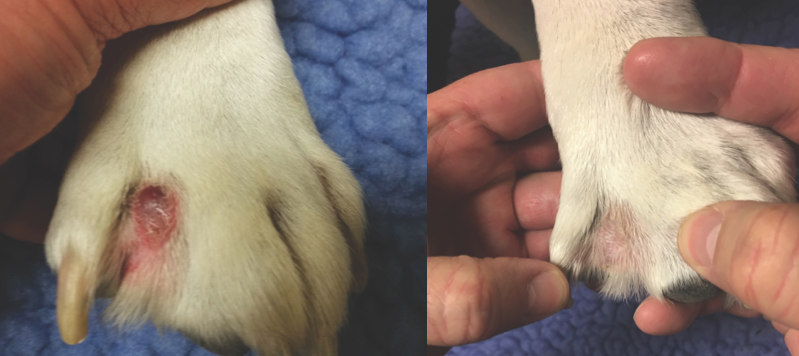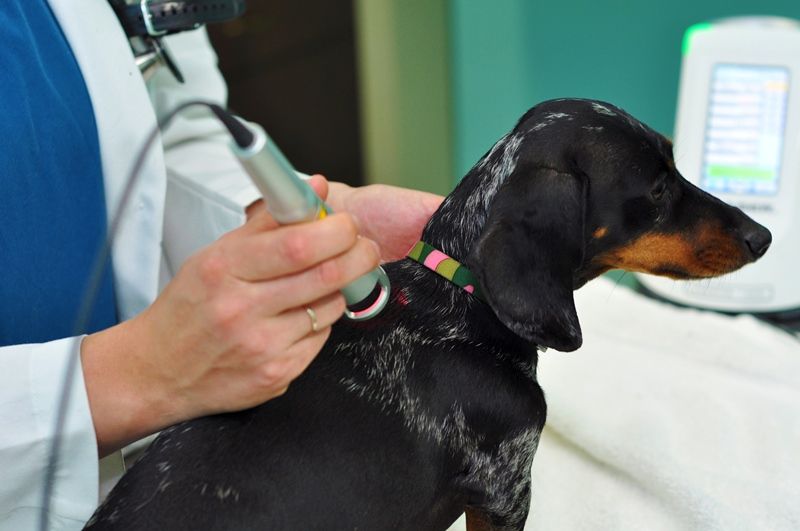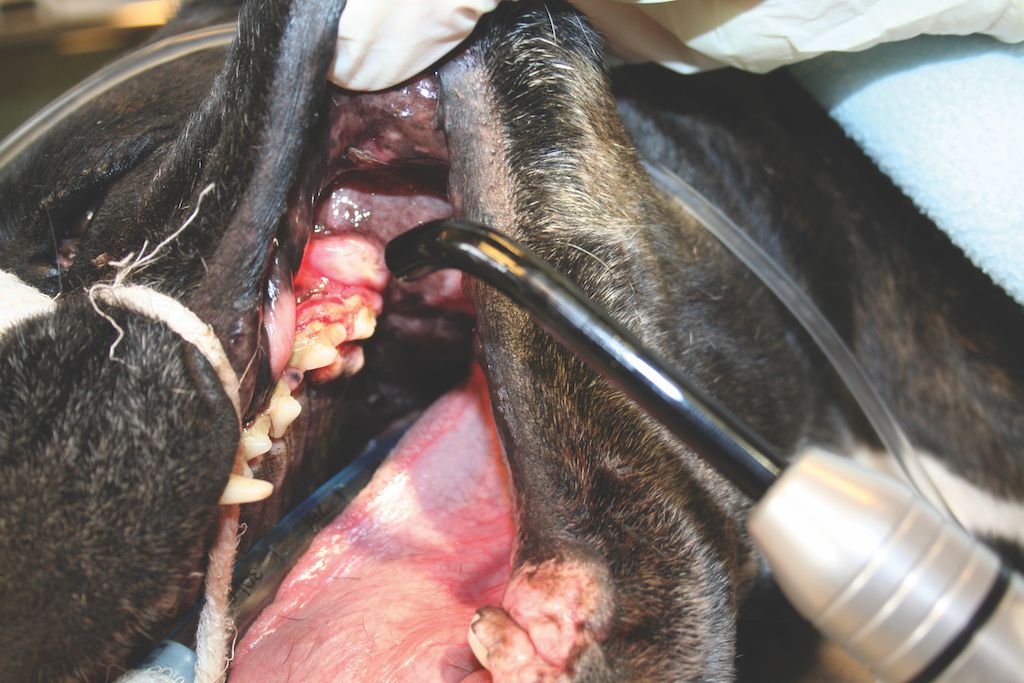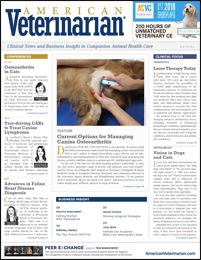Laser Therapy Today
Photobiomodulation can improve healing—and quality of life—for veterinary patients with a host of health conditions.

Interdigital cyst before (left) and 1 week after (right) laser therapy.
Documentation of light therapy dates back 3000 years, but it wasn’t until about 100 years ago that Albert Einstein theorized the possibility of a LASER (light amplification by the stimulated emission of radiation)—yet his theories did not come to fruition until 1960, when the first working laser light was produced. Since then, lasers, laser light, and light-emitting diodes have become integral to everyday life, from communication and entertainment uses to industrial and military applications.
The medical front is rife with life-changing advances attributed to lasers, including treatment of disfiguring dermatologic conditions, ophthalmologic diseases, dental and oral maladies, prostate disease, neurologic and orthopedic conditions, and intrathoracic and abdominal conditions.
RELATED:
- Laser Therapy Expanding in General Veterinary Practice
- Laser Therapy: An Emerging Field
It is estimated that about 40% of veterinary practices offer laser therapy, officially termed photobiomodulation (PBM), as part of their armamentarium. This is due in large part to a greater understanding of laser therapy and a maturing of the technology, making it safer, easier to use, and more effective on for a wider variety of clinical conditions.
How Laser Therapy Works
Laser therapy uses a wavelength-specific form of PBM to restore normal biological function and repair injured or stressed cells. Cellular chromophores within the bloodstream and tissue mitochondria absorb the laser energy, stimulating or enhancing a series of primary biochemical processes, along with a broad cascade of secondary and tertiary effects.
The primary response is a direct photochemical reaction similar to photosynthesis or vitamin D production in the skin. This occurs when photons in the infrared range emitted by the laser reach the cell mitochondria and membranes. The photonic energy is converted to chemical kinetic energy within the cell, resulting in improved efficiency of the respiratory chain within the cell mitochondria due to changes in membrane permeability, nitric oxide formation, increased oxidative metabolism to produce more adenosine triphosphate (ATP), and improved signaling between mitochondria, nuclei, and cytosol.1 Other direct effects include the production of reactive oxygen species such as superoxide dismutase and a beneficial shift in the redox state.
Secondary and tertiary reactions amplify the primary photochemical reactions, resulting in improved cell metabolism and regulation of signaling pathways responsible for tissue repair. Blood vessels and lymphatics respond favorably, enhancing tissue perfusion and providing oxygen and nutrients needed for recovery.2,3 Studies document enhanced cell migration, RNA and DNA synthesis, cell mitosis, protein secretion, and cell proliferation.4 This enhances healing and production of collagen and epithelial cells.
PBM also stimulates a more normal distribution of type I and type III collagen during the healing process.5,6 Damaged muscle and nerve cells heal faster and/or function better. The immune system, including white blood cells, functions efficiently to fight infection and clean up debris.
Not only does laser therapy enhance positive cellular processes, but it inhibits negative processes such as pain, exuberant inflammation, and aberrant immune responses. In vivo, it also stops further growth when healing is complete. This acceleration of normal healing and tissue regeneration without producing overgrowth or neoplastic transformation is a critical and unique feature of laser therapy.7-11

Laser therapy can be used to treat cervical intervertebral disk disease.
Therapeutic Uses in Veterinary Medicine
Laser therapy offers 3 main benefits: analgesia, reduced inflammation, and faster and better recovery. It allows veterinarians to improve and resolve conditions that traditionally have been less responsive to other therapies. Soft tissue, musculoskeletal, neurologic, dermatologic, and even some intra-abdominal and intrathoracic conditions can be improved or managed more efficiently and with fewer drugs by adding laser therapy to the treatment regimen.
According to the investigators in a University of Florida study on laser therapy in spinal cord—injured dogs, “the results were so profound that we’re doing this procedure now on all dogs that come to us with this condition.”12 Other areas of interest include peripheral nerve injury, traumatic brain injury, stroke, and even depression.
Laser therapy is used in a wide range of dermatologic conditions, from acute injuries, trauma, and postoperative applications to management of chronic allergic and autoimmune/idiopathic syndromes including otitis, perianal fistulas, lick granulomas, and hot spots.
Many pathologic lung conditions respond favorably to laser therapy.13-15 It has helped slow the progression and/or decrease the intensity of drug therapy in conditions such as interstitial pulmonary fibrosis (Westie lung disease), feline asthma, and even tuberculosis.
Patients with chronic kidney disease have shown clinical improvement related to appetite, well-being, and nausea. The addition of laser therapy has also demonstrated improvement in chronic bladder issues including persistent infections and feline idiopathic cystitis, and it has been used as an adjunct to improve inflammatory bowel syndromes and other enteropathies.16 There are even anecdotal reports of decreased morbidity and mortality in parvovirus enteritis with the addition of laser therapy.

Laser therapy can be used as an adjunct for periodontal disease treatment.
What to Consider
To capitalize on laser therapy, veterinarians must understand the optimal parameters that allow it to be so effective across such a broad range of applications. The most important features to consider when buying a laser are power, wavelength, delivery mode, and training and support. Buying a laser with the widest array of options or adjustability will deliver the best clinical results on the broadest number of patients and conditions.
Power
Power (watts) times time (seconds) delivers the dose (joules). In laser therapy, joules/cm2 is as critical to laser success as mg/kg of an antibiotic or mL/kg of fluid is to clinical success. The power should be adjustable from low, for small or superficial conditions or patients and acupuncture points, to high, to efficiently deliver enough energy (joules) to saturate/stimulate large areas or patients as well as deep-seated and/ or chronic musculoskeletal conditions.
Wavelength
The availability and selection of wavelength are important for optimal stimulation of different chromophores as well as levels of penetration. Roughly, this corresponds to wavelengths between 600 and 1100 nm. Shorter wavelengths are absorbed more superficially and thus cannot penetrate as readily as longer wavelengths. Wavelengths in the visible red range (660 nm) are highly absorbed by melanin and other superficial receptors. These can enhance wound healing. They may also stimulate trigger points and acupuncture points and cause release of secondary messengers that may improve other deep-seated conditions. Absorption spectra data have shown that wavelengths near the 970-nm range have moderate increased absorption by water.17,18 This is the least penetrating infrared wavelength. With higher-powered lasers, this can create some thermal gradients and increase circulation. The 905-nm wavelength is nearest the peak of the hemoglobin absorption curve. This can enhance oxygen release more efficiently. Results from recent studies have indicated that this wavelength may be able to increase oxygen release even more efficiently to tissue over the 970- to 980-nm wavelengths.
Wavelengths nearer the 800-nm range (750-830 nm) are at the peak of absorption for the cytochrome c oxidase enzyme. This is the rate-limiting step in the conversion of oxygen to ATP within the electron transport cycle. These wavelengths will accelerate the production of ATP within the mitochondria. There is new interest in the 1064-nm wavelength, particularly for its photochemical effects. This wavelength is farthest from the point of maximum melanin production, has a relative trough in the water absorption spectrum, and is still at the upper level of the cytochrome c oxidase absorption band. Therefore, it has very good penetration depth along with potent biostimulatory abilities. Having all 4 (or 5) wavelengths as well as the ability to use any combination will offer a synergistic effect and/or a wider range of treatment options across a broader spectrum of clinical conditions and patients.
Delivery Mode
Delivery mode (continuous wave, pulsed or modulated, superpulse) will enhance overall improvement and produce better clinical results. Varying pulse rates enhance different physiologic responses as well as different tissue types to a greater degree.19-21 Optimal pulsing frequencies are still being studied, but current literature consistently shows that overall clinical results will be higher if pulsing phases, rather than continuous-wave delivery, are part of the treatment protocol.22
Training
Although the technology behind laser therapy may sound complicated, training is paramount and the learning curve is not high. Ignoring or dismissing certain features will decrease the consistency in results, the degree or quality of improvement, and the number of conditions that will respond favorably. Today’s lasers are very safe and user-friendly. The protocols already set up in advanced therapeutic lasers incorporate all the parameters in a “point-and-shoot” instrument. This ease of use, along with proper training, will allow veterinary practices to institute laser therapy quickly and easily. It can and should be delegated to the staff for the most efficient treatment and economic benefits.
Conclusion
Future studies will enhance our knowledge of the variety of applications and the optimal parameters for the most effective laser therapy. The goal is not to just make our patients more comfortable—we want to return them to their normal activity level, restore range of motion, and improve muscle strength and function. Laser therapy allows performance animals to recover more quickly and more fully to regain their competitive edge and helps pets remain active members of the family.
Dr. Bradley is the veterinary medical director for K-LASER USA in Franklin, Tennessee. He began using lasers in private practice in 1999 and has worked with all types of surgical and therapeutic lasers. He was granted Fellow status in the American Society of Laser Medicine and Surgery. He has authored numerous articles and chapters and has lectured nationally and internationally on veterinary laser use.
References:
1. Karu T. Photobiology of Low Power Laser Therapy. London, UK: Harwood Academic Publishers; 1989.
2. Hawkins D, Abrahamse H. Phototherapy—A treatment modality for wound healing and pain relief. African J Biomed Res. 2007;10:99-109.
3. Kubota J. Effects of diode laser therapy on blood flow in axial pattern flaps in the rat model. Lasers Med Sci. 2002;17(3):146-153. doi: 10.1007/s101030200024.
4. Tunér J, Hode L. Some basic laser physics. In Laser Therapy - Clinical Practice and Scientific Background. Grängesberg, Sweden: Prima Books AB; 2002:12, 21, 22.
5. Wood VT. Collagen changes and realignment induced by low-level laser therapy and low-intensity ultrasound in the calcaneal tendon. Lasers Med Surg. 2010;42(6):559-565.
6. Paraguassú G, Xavier FCA, Cangussu MCT, et al. Effect of laser phototherapy (660nm) on type I and III collagen expression during wound healing in hypothyroid rats: an immunohistochemical study in a rodent model. Photomed Laser Surg. 2014;32(5):281-288. doi: 10.1089/pho.2013.3604
7. Karu T. Primary and secondary mechanisms of action of visible to near-IR radiation on cells. J Photochem Photobiol B. 1999;49(1):1-17.
8. Peavy GM. Lasers and laser-tissue interaction. Vet Clin Small Anim Pract. 2002;32(3):517-534. doi: S0195-5616(02)00003-7/pdf.
9. Martin R. Laser accelerated inflammation/pain reduction and healing. Pract Pain Manage. 2003;3(6):20-25.
10. Karu T, Kolyakov SF. Exact action spectra for cellular responses relevant to phototherapy. Photomed Laser Surg. 2005;2-5;23(4):355-361.
11. Hamblin MR, Demidova TN. Mechanisms of low level light therapy. Proc SPIE.
2006;6140(612001):1-12.
12. Draper WE. Low-level laser therapy reduces time to ambulation in dogs after hemilaminectomy: A preliminary study. J Small Anim Pract. 2012; 53:465-469.
13. Kirkby KA, Freeman DE, Morton AJ, et al. The effects of low-level laser therapy in a rat model of intestinal ischemia—reperfusion injury. Lasers Surg Med. 2012;44(7):580-587. doi: 10.1002/lsm.22060.
14. Milojevic M, Kuruc V. Laser biostimulation in the treatment of pleurisy [in Serbian]. Med Pregl. 2010;56(11-12):516-520.
15. Siqueira VPC, Evangelista MIS, Dos Santos A, et al. Light-emitting diode treatment ameliorates allergic lung inflammation in experimental model of asthma induced by ovalbumin. J Biophotonics. 2017;10(12):1683-1693. doi: 10.1002/jbio.201600247.
16. Redkin AV, Vdovin VV, Vakhtel VM, Lukyanovich PA, Malkina NA. Reduce adverse effects of laparoscopic cholecystectomy with pulse width modulated led light (625 nm, 76 Hz, 23% duty cycle). Photomed Laser Surg. 2017;35(6):293-299. doi: 10.1089/pho.2016.4211.
17. Hudson DE. Penetration of laser light at 808 and 980nm in bovine tissue samples. Photomed Laser Surg. 2013;31(4):163-168.
18. Anders JJ. Moges H, Wu X, et al. In vitro and in vivo optimization of infrared laser treatment for injured peripheral nerves. Lasers Surg Med. 2014;46:34-45. doi: 10.1002/lsm.22212
19. Cheida AA. Resonance response of cell tissue structures to impulse frequency of infrared laser radiation of low intensity. Vopr Kurortol Fizioter Lech Fiz Kult. 2002;(6):33-35.
20. Karu T. et al. Studies into the action specifics of a pulsed GaALAS laser (‘wavelength’ s20 nm) on a cell culture. Lasers Life Sci. 1999;9:211-219.
21. Karu T. Nonmonotomic behavior of the dose dependence of the radiation effect on cells in vitro exposed to pulsed laser radiation at 820 nm. Lasers Surg Med. 1997;21(5):485-492.
22. Hashmi J. Effect of pulsing in low-level light therapy. Lasers Surg Med. 2010;42(6):450-466.
